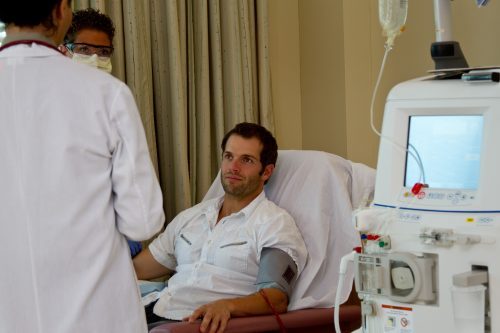
Patients with end-stage renal disease (ESRD) need lifelong kidney replacement therapy—hemodialysis (HD), peritoneal dialysis (PD), or transplantation. Nearly half (49%) of patients change modalities within the first year of starting dialysis. PD offers more flexibility than HD and is associated with lower risk of infection, better preservation of kidney function, and lower health care costs. Still, more than 35% of patients on dialysis drop out of PD in favor of HD.
A study by Xingge Sun and others examined what occurs when patients switch from HD to PD, including the rate and reasons for PD dropout and the difference in mortality following time on HD prior to switching to PD. Their results appeared in BMC Nephrology.
The researchers conducted a systematic review and meta-analysis of information from four databases: Cochrane, Embase, Medline, and PubMed. Studies that were included: (1) involved adults aged >18 years on dialysis; (2) compared two groups, including patients on HD for any length of time who then changed to PD (HD to PD group) and patients started on PD as initial therapy (PD first group); (3) demonstrated outcomes associated with the incidence or reasons for PD dropout and mortality; (4) were written in English; and (5) were randomized controlled trials, nonrandomized controlled trials, or observational studies. Exclusion criteria were also applied.
The research team identified 4966 articles from databases and five from references. After duplicate removal and screening, 20 studies were selected for full-text review. Of those, 13 were ultimately included in the systematic review; 12 were cohort studies and one was a case control study. The total number of patients and events (PD dropout and mortality) in the PD first groups and HD to PD groups were extracted from the included studies. The Mantel-Haenszel odds ratio (OR) with 95% CI was used to summarize categorical data on PD dropout and mortality in a random effects model. The I2 statistic was used to determine statistical heterogeneity.
Duration of HD varied from less than 1 month to 286 months; follow-up time ranged from 1 month to 132 months. The sample sizes of the PD first groups and HD to PD groups ranged from 37 to 9404 and 28 to 3757 patients, respectively. Patients came from America. Argentina, Australia, Canada, China, France, Iran, New Zealand, Poland, and Turkey. Patient characteristics noted in the studies included sample size, mean age, body mass index, time on HD, diabetes as a cause of ESRD, creatinine clearance, urine output, hemoglobin, albumin, and time of follow-up.
Study outcomes included factors leading to the change from HD to PD, the rate and reasons for PD dropout, and differences in mortality in the PD first group versus the HD to PD group. Meta-analysis uncovered no statistically significant difference in PD dropout in the PD first group (OR, 0.81; 95% CI, 0.61-1.09; I2=83%; P=.16). However, there was a statistically significant decrease in the rate of mortality in the PD first group (OR, 0.48; 95% CI, 0.25-0.92; I2=73%; P=.03) versus the HD to PD group.
The main reasons for switching from HD to PD included cardiovascular disease, vascular access failure, social issues, and patient preference. Reasons for PD dropout varied between the two groups, but inadequate dialysis and peritonitis were the primary reasons cited by both groups.
Limitations of the study include potential bias due to varied definitions of PD dropout across different studies and low-quality meta-analysis.
“This study confirmed that HD history may not impact PD dropout rates but could impact mortality. There were no significant differences in reasons of PD dropout in [the] PD first and HD to PD groups,” the authors concluded.
However, they emphasized the need for additional research examining the psychosocial differences between the HD to PD group and the PD first group. “In the future, multidisciplinary training and dialysis education programs could be developed to emphasize the importance of [residual renal function] assessments and evaluate the impact of providing more psychosocial support to HD patients transferring to PD,” they wrote. “There is also a need for a consensus on the definition of PD dropout to establish a standard for future research.”
Source: BMC Nephrology







 © 2025 Mashup Media, LLC, a Formedics Property. All Rights Reserved.
© 2025 Mashup Media, LLC, a Formedics Property. All Rights Reserved.